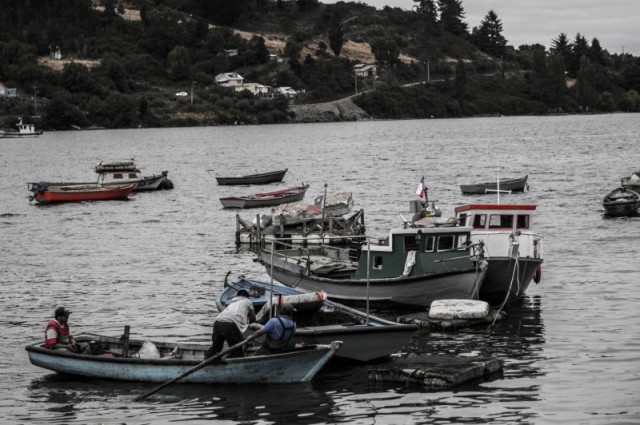Kampong Glam Heritage Trail
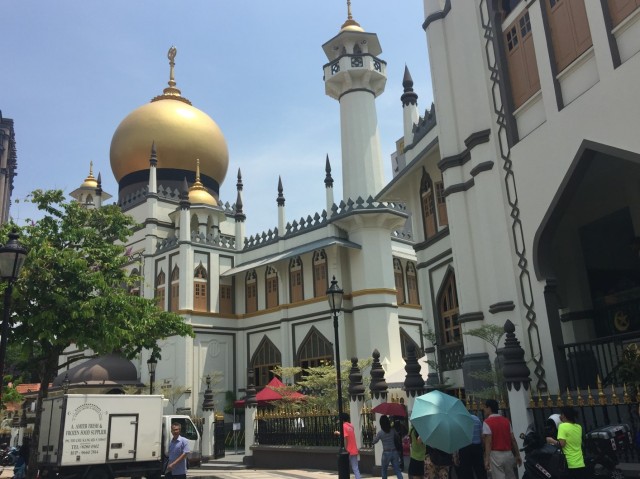
Kampong Glam
On 1 May 2016. I went with my sister to the Kampong Glam Heritage Trail. I have chosen this heritage trail as it reminded me of when I was young, I visited the Malay Heritage Centre with my family during a Malay cultural event where I got to try out many different traditional Malay games that my parents used to play during their adolescence. I remember how thrilled my parents were when they demonstrated to me how to play the games and it seemed like suddenly they were 20 years younger!
Comparatively, this second visit gave me a deeper understanding and appreciation of Kampong Glam.
- Malay Heritage Centre
The building that greeted us when we arrived was Istana Kampong Glam which was once home to Malay Royalty in Singapore. The original residence of Sultan Hussein Shah was a timber hut. The current two-storey Istana Kampong Glam was built in 1843 which was commissioned by Sultan Hussein Shah’s son, Sultan Mohammad Ali Iskandar who was recognised as the Sultan of Singapore in 1855. In 1999, the government announced plans to develop a Malay Heritage Centre which involves conserving and redeveloping Kampong Glam. Restoration work were undertaken from 1999 to 2004 and was opened in June 2005 as the Malay Heritage Centre by Prime Minister Lee Hsien Loong.

Malay Heritage Centre
- Gedung Kuning
Right beside the Malay Heritage Centre was Gedung Kuning which meant “Yellow Mansion” in Malay. When we reached the area, a wedding was currently taking place at the location. Opposite Gedung Kuning was a shop which showcased many traditional Malay instruments such as the gong and Gambus. However, they did not allow taking of pictures. The mansion was home to Tengku Mahmud, a grandson of Sultan Hussein. In 1912, Haji Yusoff, a merchant of Javanese descent bought the mansion. Gedung Kuning remained in his family’s possession until 1999 when the government acquired it for conversation works. After conversation works were completed, it was opened as a restaurant to the public in late 2003.

Malay wedding reception at Gedung Kuning
- 3. Former Pondok Java and Sultan Gate
On Baghdad Street, we were looking for Pondok Java, but to no avail. After researching more about it, I found out that due to structural safety issues, Pondok Java was demolished in 2003. The meaning of Pondoks are communal lodging houses which were set up to house newly arrived migrants from Indonesia and Malaysia. Each Pondok could accommodate 40 or more people and there is a communal hall where residents could gather for prayers and kenduri. Many of Pondok Java’s were travelling hawkers known for selling traditional Malay cuisine.
At Sultan Gate which was just in front of Baghdad street, we saw a variety of shop houses. We found out that this area was known for its blacksmiths and masons. Masons from Sultan Gate used to craft tombstones, stone mills, grinding slabs, mortar and pestles. The crafts they made were all done by hand. By the late 1990s, there were only two blacksmiths left at Sultan Gate and the last foundry closed down in the mid-2000s after a fire.
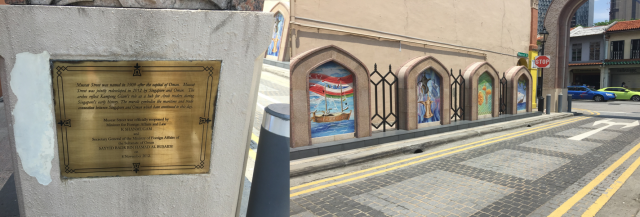
Sultan Gate
- Former Chong Cheng School and Chong Pun Girls’ School
Our next stop was the Former Chong Cheng School and Chong Pun Girls’ School which was on Aliwal Street. The building was well maintained and was converted to Aliwal Arts Centre and Food and Beverages businesses. Chong Cheng School was founded in 1903 as a boys’ school. It was originally called Yang Zheng School before changing its name in 1909. The school moved into the school compound at Aliwal Street in 1938.
Chong Pun Girls’ School was started at Thian Hock Keng Temple at Telok Ayer Street. Originally it was called Yu De Girls’ School before changing its name in 1917. These two schools shared common facilities such as the school hall. Both schools provided education when Singapore’s educational infrastructure were lacking back then.

Former Chong Cheng School and Former Chong Pun Girls’ School
- Madrasah Alsagoof Al-Arabiah (Alsagoff Arab School)
Madrasah Alsagoff Al-Arabiah is the oldest surviving madrasah in Singapore. Originally opened in March 1913, the school taught Muslim boys the tenets of Islam. In the 1940s, the school started accepting girls, as the enrolment of girls increased and boys declined over the next two decades hence the trustees of the school decided to convert it into a girls’ school. Today, its students are taught Mathematics, Science and Malay Language in addition to Islamic studies, Arabic and English.
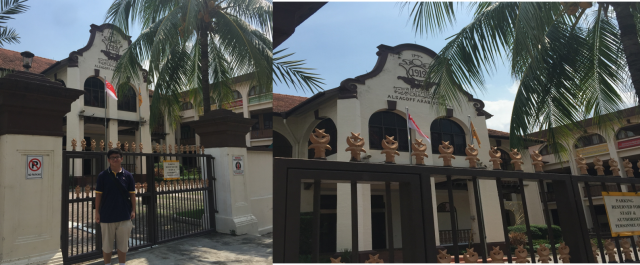
Madrasah Alsagoof Al-Arabiah
- North Bridge Road
North Bridge Road is one of the earliest built in Singapore. This road has always been one of the liveliest commercial streets in the Kampong Glam area. On this road, there were many food outlets selling Arab and Malay Cuisine food such as murtabaks, biryani and nasi padang. I saw the famous Victory eating house and Singapore Zam Zam Restauraunt Pte Ltd which is famous for Curry Fish Head.
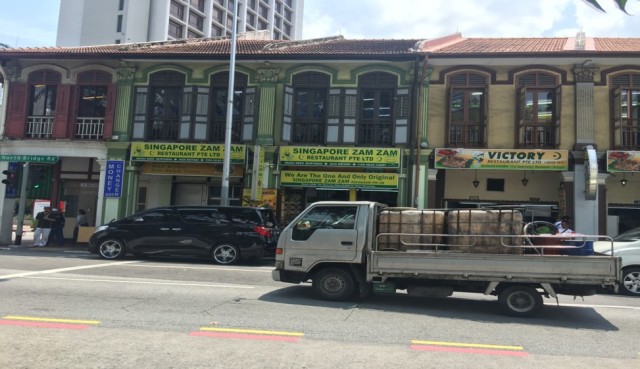
North Bridge Road
- Arab Street
On Arab street, we saw many shops selling textiles and carpets. We stopped at V.K. Abdul Samad & Co. where I met the son of the owner, Mr Hakim who is the 3rd generation of the family running this business. His father who is 56, was at home resting. This shop has been around since 1952 and is one of the oldest shop on Arab Street. I asked Mr Hakim about the history of this place and he told me that his family used to live on the second floor of the shop. However, now the second floor is used for storage purposes. Can you guess how old is Mr Hakim? He is just 20 year old, 3 years older than me!

Mr Hakim, 3rd generation of V.K. Abdul Samad & Co.
Bali Lane was part of the former Kampong Bali along with Shaikh Madersah Lane which was removed, and was approximately around present-day Ophir Road. By 1950, more Chinese had moved into Kampong Bali, many of them set up lodgings for coolies. Newcomers who could not afford rent at first could stay there first and repay the rent after they find employment.

Bali Lane
- Haji Lane
The term haji shows that a man returning from the annual pilgrimage to Mecca. Many pilgrims waiting to depart for, or returning from Mecca used to stay in Haji Lane’s shophouses. At Haji Lane, there were many murals on the walls. Haji Lane’s street art were commissioned by the local bars and cafes. The street art at Haji Lane brought the Urban Redevelopment Authority’s attention who was concerned that the bold colour of the murals were not compatible with the other shop houses in the vicinity but I like the contrast.

Vibrant Haji Lane
- Bussorah Street (former Kampong Tembaga)
Bussorah Street was originally called “Sultan Road” but was renamed in 1910 after a place in Iraq. Bussorah Street, located right in front of Masjid Sultan was renowned for its food, culture, community spirit and distinctive districts such as Kampong Tembaga, Kampong Intan and Kampong Kaji. Kampong Tembaga which means copper in Malay, was known from the Javanese coppersmiths who were once active there.
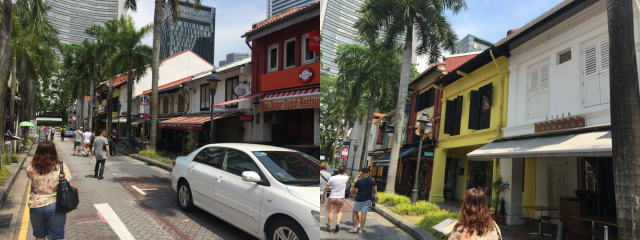
Bussorah Street
- Bussorah Street (former Kampong Kaji)
Kampong Kaji which is the Javanese pronunciation of haji, was known for its men for their knowledge of the haj. The pilgrim brokers who were called sheikh haji who were predominantly Javanese, Bugis, Banjars and Arabs were operating shop-houses in Kampong Kaji. Now, the shophouses have been turned into restauraunts.
- Masjid Sultan
In 1823, the Sultan wanted a mosque near his residence at Kampong Glam. The mosque with a simple structure with a three-tier tiled roof was built in 1824-1826. In 1879, the grandson of Sultan Hussein, Sultan Alauddin Alam Shah, gave more land to the mosque. By the early 1900s, the mosque was rebuilt. The present building was commissioned in 1924. The work was done in phases as funds were raised and prayers continued to be conducted during the construction period.
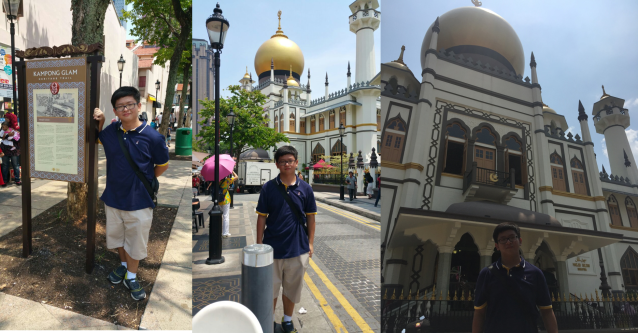
Masjid Sultan
This return visit to the trail is very fruitful for me as it brings me a deep sense of citizenry feeling about Kampong Glam. Back then, migrants and residents made their living in this place and now even though it is no longer a residential area, the government has done a great job in preserving Kampong Glam and retained her historic cultural flavours and scent in the trails that not only serve as a great tourist attraction but also for Singaporeans like me to pass down to our future generations.
In conclusion, what I’ve learnt from this visit to the Kampong Glam Heritage Trail is the history of the location I have visited and how life was in Kampong Glam. Contrary to the current day Kampong Glam, I would have never expected Kampong Glam used to be a busy area which was densely populated. The government has placed enormous efforts to preserve the heritage and cultural roots of the area by restoring the buildings to make it look more appealing. There are also signboards all around showing Kampong Glam’s rich history to both locals and tourists. To me, I feel that Kampong Glam is a great place to learn about Singapore’s history, I had never known that people from many descents lived in that area such as Banjarese and Javanese people.
We can practice Local Citizenry by finding out more about Singapore’s history and culture. Places such as this helps ensure that we can maintain and preserve our unique multicultural identity as nowadays more and more youths are unconcerned about their heritage and roots. This is due to globalisation which allowed western influence such as Starbucks, MacDonalds and pop culture to take over by storm. I feel that it is important for Singaporeans to preserve our heritage as it is an important part of our unique country. If we lose our heritage and culture, we lose our diverse history when Singaporeans from different descents practiced their rich and unique cultures.
#CA1
Resources:
http://www.nhb.gov.sg/places/sites-and-monuments/national-monuments/istana-kampong-glam
http://www.nhb.gov.sg/places/trails/kampong-glam/trail-i/trail-sites/historic-sites/gedung-kuning
http://www.nhb.gov.sg/places/trails/kampong-glam/trail-i/trail-sites/historic-sites/former-pondoks-of-kampong-glam
http://www.nhb.gov.sg/places/trails/kampong-glam/trail-i/trail-sites/historic-sites/sultan-gate
http://www.nhb.gov.sg/places/trails/kampong-glam/trail-i/trail-sites/historic-sites/former-chong-cheng-school-and-chong-pun-girls-school
http://www.nhb.gov.sg/places/trails/kampong-glam/trail-i/trail-sites/historic-sites/madrasah-alsagoff-al-arabiah-alsagoff-arab-school
http://www.nhb.gov.sg/places/trails/kampong-glam/trail-i/trail-sites/historic-sites/north-bridge-road
http://theculturetrip.com/asia/singapore/articles/singapore-s-artsy-haji-lane-the-lion-city-s-last-hidden-gem/
http://www.nhb.gov.sg/places/trails/kampong-glam/trail-i/trail-sites/historic-sites/former-kampong-bali
http://www.nhb.gov.sg/places/trails/kampong-glam/trail-i/trail-sites/historic-sites/bussorah-street
http://www.nhb.gov.sg/places/trails/kampong-glam/trail-i/trail-sites/places-of-worship/masjid-sultan




